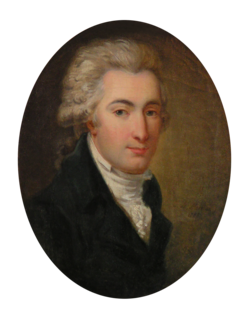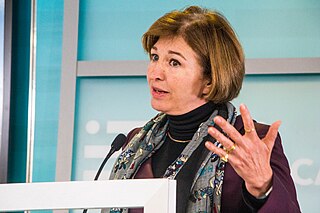
The Australian War Memorial is Australia's national memorial to the members of its armed forces and supporting organisations who have died or participated in wars involving the Commonwealth of Australia, and some conflicts involving personnel from the Australian colonies prior to Federation. The memorial includes an extensive national military museum. The Australian War Memorial was opened in 1941, and is widely regarded as one of the most significant memorials of its type in the world.

Louis Antoine de Bourbon, Duke of Enghien was a relative of the Bourbon monarchs of France. More famous for his death than for his life, he was executed on charges of aiding Britain and plotting against France. Royalty across Europe were shocked and dismayed at his execution. Tsar Alexander I of Russia was especially alarmed, and decided to curb Napoleon's power.

Charles Edwin Woodrow Bean, usually identified as C. E. W. Bean, was an Australian World War I war correspondent and historian.

The Australian and New Zealand Army Corps (ANZAC) was a First World War army corps of the Mediterranean Expeditionary Force. It was formed in Egypt in December 1914, and operated during the Gallipoli campaign. General William Birdwood commanded the corps, which primarily consisted troops from the First Australian Imperial Force and 1st New Zealand Expeditionary Force, although there were also British and Indian units attached at times throughout the campaign. The corps disbanded in 1916, following the Allied evacuation of the Gallipoli peninsula and the formation of I ANZAC Corps and II ANZAC Corps. The corps was reestablished, briefly, in the Second World War during the Battle of Greece in 1941.
The Official History of Australia in the War of 1914–1918 is a 12-volume series covering Australian involvement in the First World War. The series was edited by C.E.W. Bean, who also wrote six of the volumes and was published between 1920 and 1942. The first seven volumes deal with the Australian Imperial Force while other volumes deal with the Australian Naval and Military Expeditionary Force at Rabaul, the Royal Australian Navy, the Australian Flying Corps and the home front; the final volume is a photographic record.

Sir Ivor Henry Thomas Hele, CBE was an Australian artist noted for portraiture. He was Australia's longest serving war artist and completed more commissioned works than any other in the history of Australian art.

Anne-Marie Slaughter is an American international lawyer, foreign policy analyst, political scientist and public commentator. She received a B.A. from Princeton University in 1980, an M.Phil from Worcester College, Oxford in 1982, a J.D. from Harvard Law School in 1985, and a D.Phil in International Relations from Oxford in 1992. Most notably she is a member of the International Law Association, American Society of International Law, American Bar Association, American Academy of Arts and Sciences, and World Peace Foundation. During her academic career, she has taught at Princeton University, the University of Chicago, and Harvard University. From 2002 to 2009, she was the Dean of Princeton University's Woodrow Wilson School of Public and International Affairs and the Bert G. Kerstetter '66 University Professor of Politics and International Affairs. She was subsequently the first woman to serve as the Director of Policy Planning for the U.S. State Department from January 2009 until February 2011 under U.S. Secretary of State Hillary Clinton. She is a former president of the American Society of International Law and the current President and CEO of New America. She married Princeton professor Andrew Moravcsik; they live in Princeton with their two sons.

No. 3 Squadron is a Royal Australian Air Force (RAAF) fighter squadron, headquartered at RAAF Base Williamtown, near Newcastle, New South Wales. Established in 1916, it was one of four combat squadrons of the Australian Flying Corps during World War I, and operated on the Western Front in France before being disbanded in 1919. It was re-raised as a permanent squadron of the RAAF in 1925, and during World War II operated in the Mediterranean Theatre. The Cold War years saw the squadron disbanded and re-raised twice. It was based at RAAF Butterworth during the Malayan Emergency and the Indonesia–Malaysia Konfrontasi. Equipped with McDonnell Douglas F/A-18 Hornet multi-role fighters from 1986, the squadron deployed to Diego Garcia in 2002 to provide local air defence, and the following year contributed aircraft and crews to the invasion of Iraq as part of Operation Falconer. In April 2016, it deployed to the Middle East as part of the military intervention against ISIL.

Puckapunyal is an Australian Army training facility and base 10 km west of Seymour, in central Victoria, south-eastern Australia.

No. 452 Squadron is a Royal Australian Air Force (RAAF) air traffic control unit. It was established in 1941 as a fighter squadron, in accordance with Article XV of the Empire Air Training Scheme during World War II. The squadron flew Supermarine Spitfires for the entire war, initially over the United Kingdom and Nazi-occupied Europe. It was later based in Australia and the Netherlands East Indies, before being disbanded in 1945. It was re-raised in its current role in February 2011.

No. 60 Squadron was a Royal Australian Air Force fighter squadron of World War II. It was formed in January 1942 and disbanded three months later, without seeing combat.

Australia in the War of 1939–1945 is a 22-volume official history series covering Australian involvement in the Second World War. The series was published by the Australian War Memorial between 1952 and 1977, most of the volumes being edited by Gavin Long, who also wrote three volumes and the summary volume The Six Year War.

No. 462 Squadron is a Royal Australian Air Force (RAAF) squadron which forms part of the Information Warfare Directorate in the RAAF's Air Warfare Centre. The squadron was first formed in 1942 as a heavy bomber unit and saw combat in this role in the Mediterranean area until it was disbanded in March 1944. It was reformed in the United Kingdom in August 1944 to participate in the bombing campaign against Germany, and in December that year converted to a specialist electronic warfare unit. No. 462 Squadron continued in this role until the end of the European war in May 1945 and was disbanded in September that year. The squadron was reformed in its current role during April 2005.
The Treaty of Loudun was signed on May 3, 1616, in Loudun, France, and ended the war that originally began as a power struggle between queen mother Marie de Medici's favorite Concino Concini and Henry II de Condé, the next in line for Louis XIII's throne. The war gained religious undertones when rebellious Huguenot princes joined Condé's revolt.

The Victoria Cross (VC) is the highest and most prestigious award of the British honours system. It is awarded for gallantry "in the presence of the enemy" to members of the British Armed Forces. It may be awarded posthumously. It was previously awarded to Commonwealth countries, most of which have established their own honours systems and no longer recommend British honours. It may be awarded to a person of any military rank in any service and to civilians under military command although no civilian has received the award since 1879. Since the first awards were presented by Queen Victoria in 1857, two-thirds of all awards have been personally presented by the British monarch. These investitures are usually held at Buckingham Palace.
The Department of Information (DOI) was an Australian Government department formed during World War II. The department was established in September 1939 under the leadership of John Treloar, the director of the Australian War Memorial, who remained in the role of departmental secretary until early 1941. It was the first of 17 new Australian Government departments to be established during the war, and was responsible for both censorship and disseminating government propaganda. The department was based in Melbourne throughout its existence, though it established divisions in Sydney and bureaus in New York City and London. The DOI was broken up in 1950, with its functions being allocated between other departments.
Peter Stanley is a prominent Australian military historian, who specialises in the military-social experience of war in the late nineteenth and first half of the twentieth centuries. In a career spanning over three decades, Stanley has worked as an Historian and later Head of the Military History Section at the Australian War Memorial (1980–2007), Head of the Centre for Historical Research at the National Museum of Australia (2007–13) and, since 2013, as Research Professor at the University of New South Wales in the Australian Centre for the Study of Armed Conflict and Society. Starting in 1977—and as at 2017—Stanley has written 26 books and edited eight others, published two novels and co-authored a booklet, and composed at least 42 chapters in books and anthologies, 59 journal articles, seven encyclopaedia entries and numerous papers. In 2011, his book Bad Characters: Sex, Crime, Mutiny, Murder and the Australian Imperial Force (2010) was the joint winner of the Prime Minister's Prize for Australian History.

The Treloar Resource Centre, also known as the Treloar Centre and Treloar Technology Centre, is the Australian War Memorial's (AWM's) storage and conservation facility. It is located in the industrial suburb of Mitchell, Australian Capital Territory. The AWM describes the Treloar Resource Centre as "the Memorial's conservation facility and store for large objects of military technology, including aircraft, vehicles, boats, missiles and guns".

















